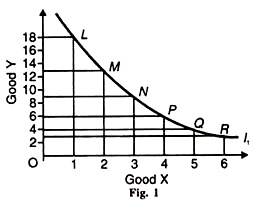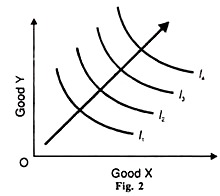In this article we will discuss about Indifference Curves. After reading this article you will learn about: 1. Meaning of Indifference Curve 2. Assumptions of Indifference Curve.
Meaning of Indifference Curve:
The indifference curve analysis measures utility ordinally. It explains consumer behaviour in terms of his preferences or rankings for different combinations of two goods, say X and Y. An indifferent curve is drawn from the indifference schedule of the consumer. The latter shows the various combinations of the two commodities such that the consumer is indifferent to those combinations.
According to Watson, “An indifference schedule is a list of combinations of two commodities the list being so arranged that a consumer is indifferent to the combinations, preferring none of any other.” The following is an imaginary indifference schedule representing the various combinations of goods X and Y.
In the following schedule (Table 1), the consumer is indifferent whether he buys the first combination of units of 18Y+1 unit of X or the fifth combination of 4 units of Y+5 units of X or any other combination. All combinations give him equal satisfaction. We have taken only one schedule, but any number of schedules can be taken for the two commodities. They may represent higher or lower satisfaction of the consumer.
If the various combinations are plotted on a diagram and are joined by a line this becomes an indifference curve, as f in the Figure 1. The indifference curve I1 is the locus of the points L, M, N, P, Q, and R, showing the combinations of the two goods X and Y between which the consumer is indifferent.
“It is the locus of points representing pairs of quantities between which the individual is indifferent, so it is termed an indifference curve.” It is, in fact, an iso-utility curve showing equal satisfaction at all its points. A single indifference curve concerns only one level of satisfaction. But there are a number of indifference curves, as shown in Figure 2.
The curves that are farther away from the origin represent higher levels of satisfaction as they have larger combinations of X and Y. Thus the indifference curve I4 indicates a higher level of satisfaction than I3 which, in turn, is indicative of a higher level of satisfaction than I2 and so on.
ADVERTISEMENTS:
Consumers would prefer to move in the direction indicated by the arrow in the figure. Such a diagram is known as an indifference map where each indifference curve corresponds to a different indifference schedule of the consumer. It is like a contour map showing the height of the land above sea-level where instead of height, each indifference curve represents a level of satisfaction.
Assumptions of Indifference Curve Analysis:
The indifference curve analysis retains some of the assumptions of the cardinal theory, rejects others and formulates its own.
The assumptions of the ordinal theory are the following:
ADVERTISEMENTS:
(1) The consumer acts rationally so as to maximise satisfaction.
(2) There are two goods X and Y
(3) The consumer possesses complete information about the prices of the goods in the market.
(4) The prices of the two goods are given.
(5) The consumer’s tastes, habits and income remain the same throughout the analysis.
(6) He prefers more of X to less of Y or more of Y to less of X.
(7) An indifference curve is negatively inclined sloping downward.
(8) An indifference curve is always convex to the origin.
(9) An indifference curve is smooth and continuous which means that the two goods are highly divisible and that level of satisfaction also change in a continuous manner.
ADVERTISEMENTS:
(10) The consumer arranges the two goods in a scale of preference which means that he has both ‘preference’ and ‘indifference’ for the goods. He is supposed to rank them in his order of preference and can state if he prefers one combination to the other or is indifferent between them.
(11) Both preference and indifference are transitive. It means that if combination A is preferable to B, and В to C, then A is preferable to C. Similarly, if the consumer is indifferent between combinations A and B, and В and C, then he is indifferent between A and C. This is an important assumption for making consistent choices among a large number of combinations.
(12) The consumer is in a position to order all possible combinations of the two goods.


